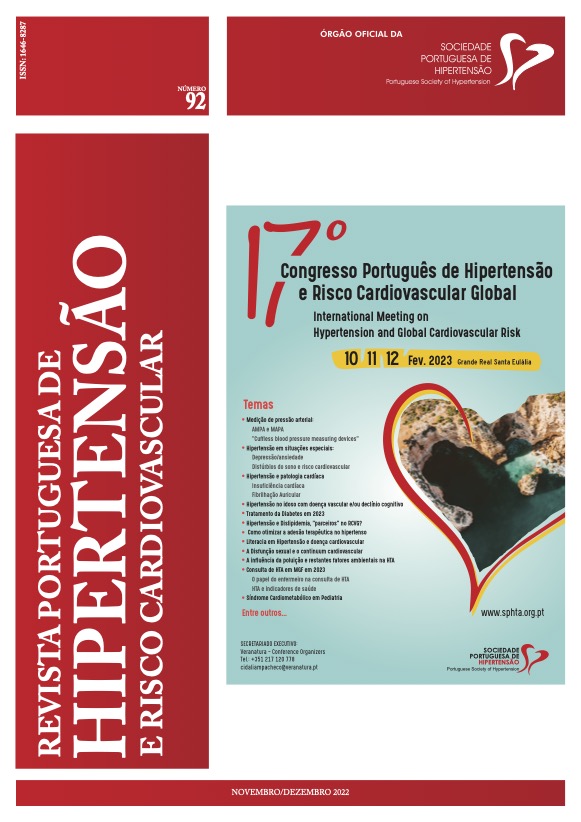IMPACT OF ARTERIAL HYPERTENSION ON HEMORRHAGIC STROKE
DOI:
https://doi.org/10.58043/rphrc.59Keywords:
Arterial hypertension, hemorrhagic stroke, ischemic strokeAbstract
Introduction: Cerebrovascular diseases continue to be one of the leading causes of morbidity and mortality worldwide. Although less frequent than ischemic strokes, hemorrhagic strokes have higher mortality rates and have arterial hypertension (AHT) as the main risk factor.
Objectives: Analyze the prevalence of AHT in patients hospitalized for hemorrhagic stroke, the demographic characteristics of this population and the impact of AHT on 30-day mortality.
Methods: Retrospective analysis of patients hospitalized for hemorrhagic stroke in the Centro Hospitalar Tondela-Viseu Stroke Unit, over a year, using SClínico records and analyzing the data using SPSS®.
Results: The sample consisted of 89 patients, with a mean age of 72.81 ± 12.81 years, 39.3% female. 60.7% had a history of AHT, of which 81.5% were medicated with antihypertensive therapy. The mean age was similar in the group with and without AHT (72.87 vs 72.71 years, p=0.950). In the hypertension group, 42.6% were women and 34.3% were women in the non-hypertensive group (p=0.433).
On average, when admitted to the emergency department, the systolic blood pressure (SBP) was 170 mmHg and the diastolic blood pressure (DBP) was 91 mmHg; 79.8% of the patients had at admission SBP greater than or equal to 140 mmHg and 51.7% had DBP greater than or equal to 90 mmHg. When compared to patients hospitalized this year with ischemic stroke (n=322), the mean value of SBP and DBP at admission was significantly higher in the group with hemorrhagic stroke (respectively, 154 vs 170 mmHg, p=0.000 and 85 vs 91 mmHg, p=0.003), although the prevalence of previously diagnosed AHT was not significantly higher (55.6% of patients with ischemic stroke also have AHT, p=0.392).
In patients with hemorrhagic stroke there was no statistically significant difference between the groups with and without history of AHT regarding 30-day mortality (16.7% vs 20.0%, p=0.689). The SBP at admission was only slightly higher in the group of patients who died in the first month compared to survivors (171 vs 169 mmHg, p=0.819), whereas the DBP was on average lower, but also without reaching statistical significance (85 vs 92 mmHg, p=0.163).
Conclusion: AHT proved to be highly prevalent in hospitalized patients with hemorrhagic stroke, with more than half of patients diagnosed with AHT prior to the event. Although most of these were on antihypertensive drugs, most had uncontrolled blood pressure values higher than hospitalized patients with ischemic stroke. The previous diagnosis of AHT had no statistically significant impact on mortality in patients with hemorrhagic stroke, at least in a short period of time, but more studies are needed, namely regarding the impact on long-term mortality and the repetition of cerebrovascular events.
Downloads
References
Roth G, Abate D, Abate K, Abay S, Abbafati C, Abbasi N, et al. Global, regional, and national age-sex- specific mortality for 282 causes of death in 195 countries and territories, 1980–2017: a systematic analysis for the Global Burden of Disease Study 2017. The Lancet. 2018;392:1736- 88. doi: 10.1016/S0140-6736(18)32203-7.
Poon MT, Bell SM, Al-Shahi Salman R. Epidemiology of Intracerebral Haemorrhage. Front Neurol Neurosci. 2015;37:1-12. doi: 10.1159/000437109.
Woo D, Sauerbeck LR, Kissela BM, Khoury JC, Szaflarski JP, Gebel J, et al. Genetic and environmental risk factors for intracerebral hemorrhage: preliminary results of a population-based study. Stroke. 2002;33(5):1190-5. doi: 10.1161/01.str.0000014774.88027.22.
Woo D, Haverbusch M, Sekar P, Kissela B, Khoury J, Schneider A, et al. Effect of untreated hypertension on hemorrhagic stroke. Stroke. 2004;35(7):1703-8. doi: 10.1161/01.STR.0000130855.70683.c8.
Feldmann E, Broderick JP, Kernan WN, Viscoli CM, Brass LM, Brott T, et al. Major risk factors for intracerebral hemorrhage in the young are modifiable. Stroke. 2005;36(9):1881-5. doi: 10.1161/01. STR.0000177480.62341.6b.
Zia E, Hedblad B, Pessah-Rasmussen H, Berglund G, Janzon L, Engström G. Blood pressure in relation to the incidence of cerebral infarction and intracerebral hemorrhage. Hypertensive hemorrhage: debated nomenclature is still relevant. Stroke. 2007;38(10):2681-5. doi: 10.1161/ STROKEAHA.106.479725.
Martini SR, Flaherty ML, Brown WM, Haverbusch M, Comeau ME, Sauerbeck LR, et al. Risk factors for intracerebral hemorrhage differ according to hemorrhage location. Neurology. 2012;79(23):2275-82. doi: 10.1212/ WNL.0b013e318276896f.
Ariesen MJ, Claus SP, Rinkel GJ, Algra A. Risk factors for intracerebral hemorrhage in the general population: a systematic review. Stroke. 2003;34(8):2060-5. doi: 10.1161/01. STR.0000080678.09344.8D.
Sturgeon JD, Folsom AR, Longstreth WT Jr, Shahar E, Rosamond WD, Cushman M. Risk factors for intracerebral hemorrhage in a pooled prospective study. Stroke. 2007;38(10):2718-25. doi: 10.1161/ STROKEAHA.107.487090
O’Donnell MJ, Xavier D, Liu L, Zhang H, Chin SL, Rao-Melacini P,et al.Risk factors for ischaemic and intracerebral haemorrhagic stroke in 22 countries (the INTERSTROKE study): a case-control study. Lancet. 2010;376(9735):112-23. doi: 10.1016/S0140-6736(10)60834-3.
Song YM, Sung J, Lawlor DA, Davey Smith G, Shin Y, Ebrahim S. Blood pressure, haemorrhagic stroke, and ischaemic stroke: the Korean national prospective occupational cohort study. BMJ. 2004;328(7435):324-5. doi: 10.1136/ bmj.328.7435.324.
Rordorf G, McDonald C: Spontaneous intracerebral hemorrhage: Acute treatment and prognosis. In: UpToDate, Post TW (Ed), UpToDate (Consultado em 23 de Outubro, 2021).
Zhang Y, Reilly KH, Tong W, Xu T, Chen J, Bazzano LA, et al. Blood pressure and clinical outcome among patients with acute stroke in Inner Mongolia, China. J Hypertens. 2008;26(7):1446-52. doi: 10.1097/HJH.0b013e328300a24a.
Divani AA, Liu X, Di Napoli M, Lattanzi S, Ziai W, James ML, et al. Blood Pressure Variability Predicts Poor In-Hospital Outcome in Spontaneous Intracerebral Hemorrhage. Stroke. 2019;50(8):2023-2029. doi: 10.1161/ STROKEAHA.119.025514.
Manning L, Hirakawa Y, Arima H, Wang X, Chalmers J, Wang J, et al. Blood pressure variability and outcome after acute intracerebral haemorrhage: a post-hoc analysis of INTERACT2, a randomised controlled trial. Lancet Neurol. 2014 Apr;13(4):364-73. doi: 10.1016/S1474- 4422(14)70018-3.





